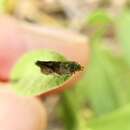en
names in breadcrumbs


Douglasiidae is a small Lepidopteran family including around 28 species of micromoth whose adults are collectively called Douglas moths. The largest genus in the family is Tinagma. They are primarily found in the Palearctic (20 spp.) and Nearctic realms. The adults have a 6 to 15 mm wingspan, with a reduced hindwing venation and long fringes. The larvae are leaf miners or borers, primarily in stems and petioles, belonging to Boraginaceae, Labiatae, and Rosaceae.[1]
Douglasiidae is a small Lepidopteran family including around 28 species of micromoth whose adults are collectively called Douglas moths. The largest genus in the family is Tinagma. They are primarily found in the Palearctic (20 spp.) and Nearctic realms. The adults have a 6 to 15 mm wingspan, with a reduced hindwing venation and long fringes. The larvae are leaf miners or borers, primarily in stems and petioles, belonging to Boraginaceae, Labiatae, and Rosaceae.